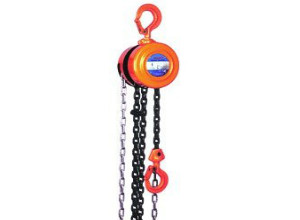George Taylor Viper Chain Block review
- Distributor – George Taylor
- Capacity – 1/2 ton (2,000 lbs) to 30 tons (60,000 lbs)
- Material – Heavy duty cast iron, zink
- Lifting range – 118 to 393 inches (3 to 10 m)
- Weight – 15.4 lbs (7 kg) to 502.6 lbs (228 kg)
Check Pricing and Purchase George Taylor Viper Chain Block
Review

This chain hoist block is manufactured by George Taylor, a UK lifting, hoisting and mechanical handling product manufacturer with over 4 decades of experience in quality product manufacturing.
Their Viper Chain Block is a unique product, because it offers 8 different lifting capacity options and three different height of lift options. For the capacity there are viper chain blocks that are able to lift load that is just about 500 kilograms and then there are blocks that can lift loads that are whopping 30,000 kilograms, so you can use this chain hoist as a home use lifting assistant or as commercial lifter for different construction, car repair and other similar jobs. But the height of lift options for these chain hoists are 118, 236 and 393 inches (3, 6, 10 m), meaning that depending on which height you chose, the chain that will come with the hoist will be in different lengths.
Although using this type of hoist you will have to use some effort to lift the loads, this effort is not as bad as you might think. If you will want to lift the lightest load capacity of 500 kilograms, then you will have to put in about 210 newtons worth of effort to do that, which roughly translates to about 47 pound (21 kg) load, so really instead of lifting the whole ½ ton it will feel like you are lifting only about 47 pounds. But for the heaviest load capacity the newtons you will need to lift it will be 740 newtons that can be calculated to about 166 lbs. (75 kg) which if you think about it is very little compared to the fact that you will actually be lifting 30 ton weight.
Construction
The materials that are used to make these chain hoists are heavy duty cast iron, from which the safety catches are made, meaning that they will be very long lasting and secure enough to lift even 30 ton loads. But the chains are made from Zinc plates and the load chain is grade 80 chain, so both of them are extremely efficient and able to withstand huge loads.
Load chain
Speaking of the load chain that is used to lift loads with this particular chain hoist, the diameter of the chain varies from 0.23 inches (6 mm) for chain in ½ ton and 1 ton lifting hoists, to 0.27 inches (7.1 mm) for 1 ½ ton and 3 ton hoists and 0.31 inches (8 mm) for 2 ton hoists to 0.39 inches (10 mm) for the 5, 10, 20 and 30 ton capacity hoists. And the weight of the chain too grows, as the chain gets thicker and has to handle more weight.
Size and weight
The size and weight of the chain hoist differs, based on the weight it is meant to lift, so the ½ ton chin hoist will be smaller as well as lighter whereas the one that is meant for lifting 30 tons will be bulky but able to get the job done. The approximate measurements for the ½ to hoist frame are 4.9 inches (126.5 mm), but for the 30 ton capacity hoists this size is 26.3 inches (670 mm).
Check Pricing and Purchase George Taylor Viper Chain Block
Advantages
- Based on which capacity you buy, this chain hoist will be able to lift from 500 kg to 30,000 kg heavy loads;
- The hoist comes with a sturdy and durable chain in 3 different sizes, so you can chose the most suitable one for you;
- The effort you will have to put in to actually lift any of the loads will be more than 10 times smaller than the weight of the actual load you are lifting, thanks to the mechanism inside of the chain hoist;
- Hoist is made from heavy duty materials that will ensure that your hoist is up to task to lift even 30 ton loads.
Disadvantages
- Because it is a chain hoist, you will have to install it in the space, where you will be using it, which could not be possible in all workshops, garages or other spaces.
- Floor Jack Storage Ideas and Tips - November 19, 2019
- Tips for Using a Car Jack - November 12, 2019
- How Often Should You Wash Your Car in the Winter? - November 5, 2019



Leave a Reply